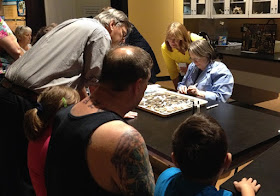During the dog days of summer, The State Museum of
Pennsylvania offers opportunities for all ages to beat the heat with special
events and educational activities. This Week in Archaeology we invite you to
take full advantage of our upcoming summer programming to get out of the sun
and learn something new.
Once again, Wednesdays and Thursdays at 11:30 AM through the
month of August science curators and outside partners are presenting on a wide
range of topics and providing hands-on activities in the Nature Lab with the cost of
admission. Don’t miss out on free admission / pay as you wish every Friday during
Learn at Lunchtime.
Archaeology staff begin their contributions to the
programming next Thursday, July 25th bringing back by popular demand
our mock lab artifact processing demonstration and chance for children ages 3
and up to handle and wash prehistoric stone tools and chipping debris from the William
Frederick Veigh Collection. Follow the links and read further for a full
listing of archaeology summer programs presented by The Section of Archaeology
at The State Museum.
Thursday, July 25 Nature Lab, 11:30 AM: Preserving our Past:
Archaeology Lab, Andrea Carr and Callista Holmes, Laboratory
Managers and Andrew Shriner, Intern
Get a behind-the-scenes view and help process artifacts with the
Section of Archaeology laboratory staff, interns and volunteers. While
demonstrating conservation techniques, laboratory managers Andrea Carr and
Callista Holmes will discuss artifact care, provide background about the
current collections that are processed in the lab and how these collections fit
into the larger picture of preserving our past for our future at The State
Museum. This presentation is participatory and inter-active. Questions about
recording archaeological sites, documenting and conserving artifacts, donating
collections, and the Section of Archaeology’s essential function as the central
repository for archaeological investigations in Pennsylvania are encouraged and
welcome.
Thursday, August 1 Nature Lab, 11:30 AM: Measuring and Mapping in
Archaeology with State Museum’s Section of Archaeology, Janet
Johnson and Melanie Mayhew, Curators
Archaeologists use math and science
in excavations and in analyzing artifacts. Participate in mapping and measuring
artifacts and how science has helped us to interpret our past. This is a STEM
activity geared toward first through sixth grade children. Math manipulative
objects are provided for younger participants.
Friday, August 2 Learn at Lunchtime, 12:15 PM: Discovering the Past at Fort
Hunter with Janet Johnson, Curator of Archaeology in The State
Museum
Archaeologists will share their
discoveries from excavations at Fort Hunter Mansion & Park. Artifacts
recovered here help to tell the story of daily activities of Native Americans
9,000 year ago, it’s role in the French & Indian War through the colonial
period to present day.
Thursday, August 8 Nature Lab, 11:30 AM: Chipped Stone and the
Prehistoric Toolbox featuring Steve Nissly, expert flint knapper, and Section
of Archaeology curators Kurt Carr, Dave Burke and intern Alaina Helm.
This demonstration of stone tool
technology will illustrate the methods and materials used by Indians in
producing chipped stone tools. In addition, Alaina Helm will present the
results of her wood scraping experiment where she tested the durability of
different types of stone commonly used by Indians in scraping activities.
Thursday, August 15 Nature Lab, 11:30 AM: Pots of Clay and What They
Say with State Museum’s Section of Archaeology, Jim
Herbstritt, Historic Preservation Specialist and Kimberly Sebestyen, Curator.
Take a look at the history of
Native American pottery and its importance in Archaeology. Make your own clay pot
using construction techniques from before the invention of the potter’s wheel.
We hope to see you at our upcoming
summer series events at The State Museum, and thank you for your continued
interest, effort and support saving our past for our future!
For more information, visit PAarchaeology.state.pa.us or the Hall of Anthropology and Archaeology at The State Museum of Pennsylvania .










